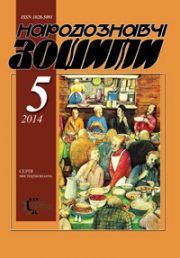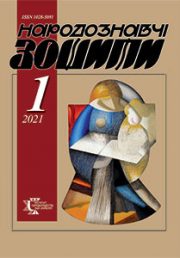The Ethnology Notebooks. 2023. № 4 (172), 841—849
UDK [39:061.2(477.83-25)НТШ]:271-725
DOI https://doi.org/10.15407/nz2023.04.841
CLERGY IN THE ACTIVITIES OF THE ETHNOGRAPHIC COMMISSION OF NTSH
SAPELYAK Oksana
- ORCID ID: https://orcid.org/0000-0001-8111-6563
- Candidate of Historical Sciences, Senior Research Associate,
- Active Member of the Shevchenko Scientific Society,
- Institute of Ethnology of the National Academy
- of Sciences of Ukraine,
- Departament of Modern Ethnology,
- 15, Svobody Avenue, 79000, Lviv, Ukraine,
- Contacts: e-mail: oksana.sapelyak@gmail.com
Abstract. Formulation of the problem. On the initiative of the Chairman of the Branch of the Shevchenko Scientific Society and the head of the historical and philological section Mykhailo Hrushevsky 1895 «Ethnographic collection» began to be published. At the same time, M. Hrushevsky expressed an opinion about the creation of an Ethnographic Commission within the structure of the National Academy of Sciences, which would deal with the development of ethnological science. The chairman of the commission was Ivan Franko (doctor of philosophy, received the title in 1894 at the University of Vienna), whose role as an organizer of scientific research was undeniably great, highly appreciated in Ukraine and beyond. Volodymyr Hnatyuk, a young scientist, was elected secretary of the commission, with his name all its organizational activities are connected.
Compared to other commissions of the Society, the ethnographic commission was much more active. It had two series of publications («Ethnographic Collection» and «Materials for Ukrainian-Russian Ethnology»), conducted ethnographic expeditions annually, and had a significant budget (for paying storytellers and collectors of materials, for photography, and purchasing exhibits for the Museum of the National Academy of Sciences). To carry out all the enormous work its organizers involved a wide range of intelligentsia and peasants. First of all, Ukrainian priests participated in all areas of the commission’s work.
In the article, the author set the goal: to find out the range of cooperation of the clergy with the Ethnographic Commission of the National Academy of Sciences.
The object of this publication is to outline the contribution of priests to the activities of the Ethnographic Commission, and the subject is the work of specific ministers of the Greek-Catholic and Orthodox Churches in the commission.
The methodological basis is the principle of historicism and analysis.
The significance for Ukrainian science and culture of the activities of the Ukrainian clergy in the Ethnographic Commission was clarified by the method of historical and systemic analysis.
Keywords: Ethnographic Commission, collection work, museum work, organizational work, publications.
Received 21.06.2023
REFERENCES
- Central State Historical Archive of Ukraine in Lviv (TsDIA). F. 309. Op. 1. Issue 2. Sheet. 20 [in Ukrainian].
- Hrushevsky, M. (1898). Notes to the general assembly of 1898 Notes of the National Academy of Sciences (Vol. 21, book 1, pp. 10—17) [in Ukrainian].
- Bilyi, B. (2017). Greek-Catholic bishops, priests, laymen of the Przemyњl Diocese in the matter of preserving faith, rites, tradition, education, culture and national identity. Worldview, 3 (65), 64—75 [in Ukrainian].
- Hrycak, J. (1936). Industry a hundred years ago. Przemyњl: published by the Society of Art Supporters [in Ukrainian].
- Arsenycz, P. (1995). Teacher and ethnographer Luka Harmatii. Hutsul school, 1, 70-73 [in Ukrainian].
- (1902, 1906). Chronicle of NTSH (Part 2, p. 19; part 29) [in Ukrainian].
- Hnatiuk, V. (Ed.). (1899). Foreword Galician-Russian anecdotes. Ethnographic collection (Vol. 6). Lviv [in Ukrainian].
- Vovk, F. (1895). The program for collecting information about the Ukrainian-Russian region and the people was put together by members of the Shevchenko Scientific Society. Ethnographic collection (Vol. 1, pp. 1—16). Lviv [in Ukrainian].
- Archive of the Institute of Art History, Folklore and Ethnography named after M.T. Rylskyi (IMFE). F. 28. Op. 1. Issue 12 [in Ukrainian].
- Demiyan, H. (1992). Letters of Volodymyr Hnatyuk to Mykhailo Zubrytskyi. Notes of the National Academy of Sciences (Vol. 223, p. 301). Lviv [in Ukrainian].
- Hrushevski, M. (1906—1907). A child in the customs and beliefs of the Ukrainian people. Materials for Ukrainian-Russian ethnology (Vol. 1—2). Lviv [in Ukrainian].
- IMF. F. 29. Op. 3. Issue 280 [in Ukrainian].
- Mazurok, O. (2010). «The most learned and the most competent in the ethnographic affairs of Ruthenians in the whole of Hungary» (to the 155th anniversary of the birth of Yury Zhatkovich). Uzhhorod [in Ukrainian].
- Kyrcziv, R. (2010). Kyrcziv family. Uzhhorod [in Ukrainian].
- (1900). Report on the ethnographic expedition. Chronicle of NTSH (Part 4, pp. 18—19). Lviv [in Ukrainian].
- (1903). Report on anthropological excursions by Dr. Fedir Vovk. Chronicle of the National Academy of Sciences (Part 16, pp. 13—14) [in Ukrainian].
- Franko, I. (1898). Opryshok Myron Shtola. Ethnographic collection (Vol. 5, pp. 32—40; Franko, I. (1898). Hutsul proverbs. Ethnographic collection (Vol. 5, pp. 41—72) [in Ukrainian].
- Kukula, S. Ivan Franko in Dovgopol Halytskyi at father Ivan Popel. Retrieved from: lib.if.ua/franko/1312193571
- Pryima, O. Clergy from the noble family of the Ashes of the coat of arms of Sulima and the coat of arms of Sas in Galicia in the 19th-20th centuries. Retrieved from: risu.ua/svyashchenstwo-z-shlyahetnoho-rodu-popeliv [in Ukrainian].
- Central Institute of Ukraine in Lviv. F. 309. Op. 1. Issue 42. Ark. 57 [in Ukrainian].
- Central Institute of Ukraine in Lviv. F. 309. Op. 1. Issue 82. Sheet. 2 [in Ukrainian].
- Vovk, F. (1908). Anthropometric studies of the Ukrainian population of Galicia, Bukovyna and Hungary. Materials for Ukrainian-Russian ethnology (Vol. 10, pp. 1—67). Lviv [in Ukrainian].
- Rakovsii, I. (1929). Prehistoric motifs in Ukrainian folk art. Materials for ethnology and anthropology (Vol. 21—22, pp. 163—186 [in Ukrainian].
- Central Institute of Ukraine in Lviv. F. 309. Op. 1. Issue 746. Ark. 2—3 [in Ukrainian].
- (1904). Meetings of sections and commissions. Chronicle of NTSH (Part 19, p. 18) [in Ukrainian].
- Zhatkovich, Yu. (1896). Ethnographic notes from Hungarian Rus’. Ethnographic collection (Vol. 2, pp. 1—38) [in Ukrainian].
- Hnatiuk, V. (1898). Foreword Ethnographic materials from Hungarian Rus. Ethnographic collection (Vol. 4, p. VIII) [in Ukrainian].
- Franko, I. (1896). Galician local history. Collected works: in the 50th volume. (Vol. 46, book 2, pp. 116—150). Kyiv [in Ukrainian].





